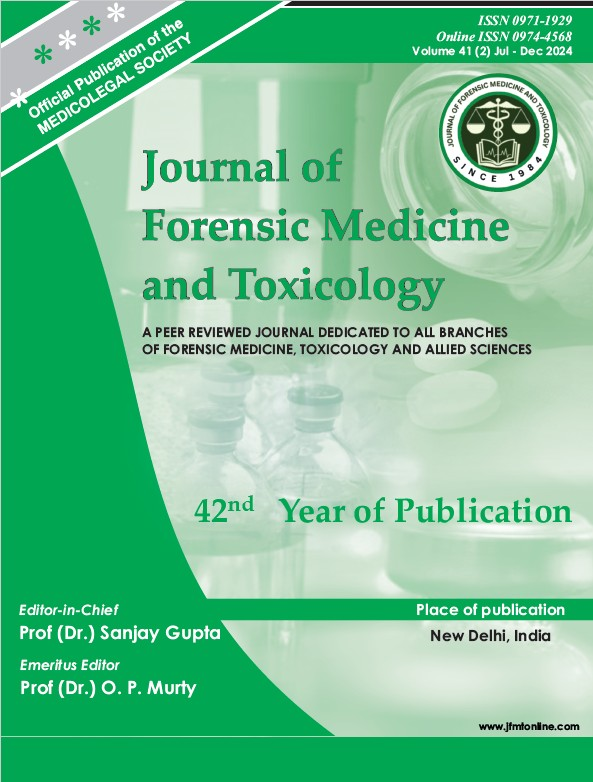A CROSS SECTIONAL STUDY OF PREVALENCE AND AWARENESS OF ‘NEEDLE-STICK INJURIES’ IN MEDICAL AND PARAMEDICAL PROFESSIONALS
DOI:
https://doi.org/10.48165/jfmt.2024.41.2.6Keywords:
Needle Stick Injury, Sharp injury, Work place injury, Occupational injuryAbstract
Background: Needle Stick Injuries(NSI) are accidental skin penetrating injuries by sharp medical instruments to healthcare professionals which may transmit infections or diseases. This occupational injury needs to be addressed seriously. We conducted a cross sectional study regarding prevalence and awareness of NSI among medical and paramedical professionals. Objectives : To assess the awareness of medical and paramedical professionals regarding Needle Stick Injuries and related aspects. To discover the prevalence of needle stick injuries in medical and paramedical professionals. Materials & Methods: We conducted a cross sectional observational study with pre-validated questionnaire. Total 100 participants were enrolled as per inclusion and exclusion criteria. Collected data analyzed & reported. Results: 43% participants were doctors, 33% were nurses, 12% were dentists and 12% were paramedical professionals. 45% participants were from paramedical branch, 39% from surgical branch, 13% were from general and 3% were from medicine & allied branches. 83% participants answered that they were aware about PreExposure Prophylaxis Guidelines for HIV, while 17% were not aware. 85% participants answered that they get regular training for proper use and disposal of sharp instruments, 15% answered No for it. 26% subjects were right about how long a needle remains infective for HIV, HBV & HCV after use, 26% were partially correct and majority subjects 48% were wrong. 53% participants answered correct about what investigations to be done in oneself if get injured by NSI, 12% gave wrong answer while 53% were partially correct. 23% participants had got injured by NSI during their professional works. 43% were aware about immediate steps after getting NSI. 59% got HBV Vaccine every 5yrly, while 24% got it only once and 17% didn’t remember or not taken. Conclusion: The prevalence of NSI in our study was 23%. Majority participants were aware about NSI, but the knowledge and practice of majority of them were either wrong or partially correct. NSI is a common work place injury among medical and paramedical professions so, awareness & alertness about it are necessary.
Downloads
References
The National Surveillance System for Healthcare Workers (NaSH) Summary Report for Blood and Body Fluid Exposure(1995–2007). Centres for Disease Control & Prevention, USA. 2011. [accessed on 2024 Apr 12]. Available from: https://www.cdc.gov/nhsn/ PDFs/NaSH/NaSH-Report-6-2011.pdf
Apisarnthanarak A, Babcock HM, Fraser VJ. Compliance with universal precautions among medical students in a tertiary care center in Thailand. Infect Control Hosp Epidemiol 2006;27:1409-10.
Rapiti E, Prüss-Üstün A, Hutin Y. Sharps injuries: assessing the burden of disease from sharps injuries to health-care workers at national and local levels. Geneva, World Health Organization, 2005. (WHO Environmental Burden of Disease Series, No. 11). [Accessed on 2024 Apr 12]. Available from: https:// www.who.int/publications/i/item/sharps-injuries assessing-the-burden-of-disease-from-sharps injuries-to-health-care-workers-at-national-and-local levels
Townsend, Beauchamp, Evers, Mattox. Viral Hepatitis And The Surgeon. Sabiston Textbook of Surgery, 18th ed. USA: Elsevier; 2008.
Human Immunodeficiency Virus Disease: AIDS and Related Disorders Harrison’s Principles of Internal Medicine, 19th ed. USA: McGraw-Hill Education; 2015.
National AIDS Control Organization, MOHFW, GOI. Antiretroviral Therapy Guidelines for HIV-Infected Adults and Adolescents Including Post-exposure Prophylaxis. Available from: http://naco.gov.in/sites/ default/files/1.%20Antiretroviral%20Therapy%20 Guidelines%20for%20HIV-Infected%20Adults %20and% 20Adolescents%20Including%20Post exposure.pdf [Accessed on 2024 Apr 24]
National Center for Infectious Diseases(U.S.) “Exposure to blood; what healthcare personnel need to know”, 2003. Available from: https://stacks.cdc.gov/ view/cdc/6853 [Accessed on 2024 Apr 24]
Kumar A, Srinivas KSN, Sathyan S, Singh SB, Vannya MS. Proportion of needle stick injury and its characteristics among nursing staffs in a tertiary care teaching hospital in Trivandrum, South India. Indian J Forensic Community Med 2019;6(2):61-5. http:// doi.org/10.18231/j.ijfcm.2019.015
P PK, C S, K S, Shenbagasree. Occupational Exposure to Blood and Body Fluids among Post-graduate Students in Tamilnadu: A Cross-sectional Study. J Assoc Physicians India. 2019 Jan;67(1):18-20. PMID:
Singru SA, Banerjee A. Occupational exposure to blood and body fluids among health care workers in a teaching hospital in mumbai, India. Indian J Community Med. 2008 Jan;33(1):26-30. doi: 10.4103/0970- 0218.39239. PMID: 19966992; PMCID: PMC2782223.
Mengistu DA, Tolera ST. Prevalence of occupational exposure to needle-stick injury and associated factors among healthcare workers of developing countries: Systematic review. J Occup Health. 2020; 62: e12179. https://doi.org/10.1002/1348-9585.12179
Lakshami GNSS, Bhat R. A study on awareness on Needle stick injury in students undergoing paramedical cource. IOSR Journal of Dental And Medical Sciences, 2015; 14(11): p34-38.
Solanky P et al. Knowledge and practice of universal precautions among nursing staff at a tertiary care hospital in South Gujarat, India Int J Community Med Public Health. 2016 Sep;3(9):2373-2376. Available from: http://dx.doi.org/10.18203/2394-6040.ijcmph20162890 [Accessed on 2024 Apr 12]
Gurubacharya DL, Mathura KC, Karki DB. Knowledge, attitude and practices among health care workers on needle-stick injuries. Kathmandu Univ Med J (KUMJ). 2003 Apr-Jun;1(2):91-4. PMID: 16388204.
National AIDS Control Organization, MOHFW, GOI. National Guidelines on Prevention, Management and Control of Reproductive Tract Infections including
Sexually Transmitted Infections; 2007. Available from: h t t p : / / n a c o . g o v. i n / s i t e s / d e f a u l t / f i l e s / National_Guidelines_on_ PMC_of_RTI_Including_ STI%201.pdf [Accessed on 2024 Apr 12]
Xu X, Yin Y, Wang H, Wang F. Prevalence of needle stick injury among nursing students: A systematic review and meta-analysis. Front Public Health. 2022 Aug 15;10:937887. doi: 10.3389/fpubh.2022.93 7887. PMID: 36045726; PMCID: PMC9421142.
Directorate General of Health Services & Central Pollution Control Board. Guidelines for Management of Healthcare Waste as per Biomedical Waste Management Rules [Internet]. 2016. Available from: https://cpcb.nic.in/uploads/Projects/Bio-Medical Waste/Guidelines_healthcare_June_2018.pdf [Accessed on 2024 Apr 24]
Man injects ex-wife with HIV-infected blood in Gujarat’s Surat [Internet]. India Today. 2022. Available from: https://www.indiatoday.in/crime/story/man injects-wife-with-hiv-infected-blood-in-surat-2313868- 2022-12-27
HIV-infected man injects wife with own blood for sex [Internet]. Deccan Herald. Available from: https:// www.deccanherald.com/archives/hiv-infected-man injects-wife-2576120 [Accessed on 2024 Apr 24]
The Workmans’ Compensation Act [Internet]. 1923. Available from: https://labour.gov.in/sites/default/ files/theworkmenact19231.pdf [Accessed on 2024 Apr 24]




